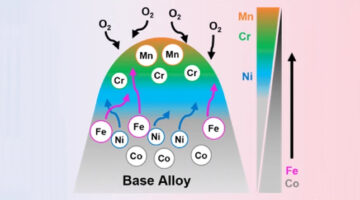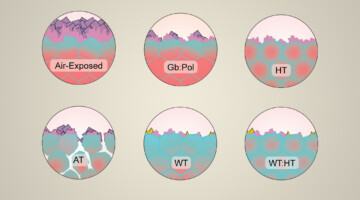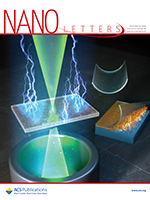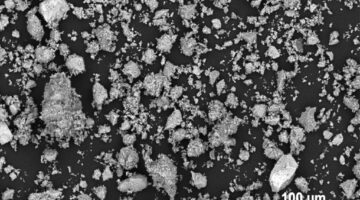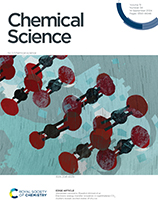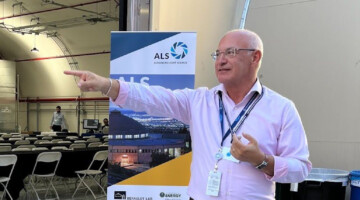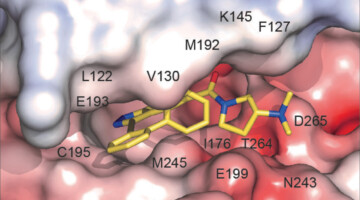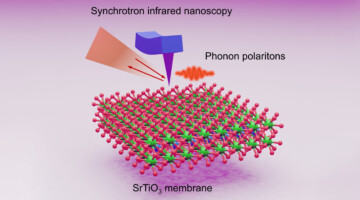For extreme applications such as nuclear fusion reactors and high-temperature jet engines, scientists are experimenting with “high-entropy” alloys that consist of many metals mixed together in equal proportions. In this work, researchers begin to unravel how these materials degrade under high-temperature oxidative environments. Read more »![]()
Studying Interfacial Effects in Solid-Electrolyte Batteries
An ambient-pressure probe of a solid electrolyte revealed how surface electrochemical mechanisms lead to poor electrolyte performance and battery failure. The results can help scientists engineer better coatings and interfaces, which are essential for building safer and better-performing batteries, particularly for use in vehicles. Read more »![]()
![]()
ALS in the News (October 2024)
-
-
-
-
-
- S. Korean scientists make 1st discovery of electronic crystallites in solids
- 2024 Nobel Prize in Chemistry awarded to UW scientist with several Lab connections
- Standing up the nation’s supercomputing pipeline for streaming big data in real time
- Advanced Light Source operational performance benefits from machine learning
- With DOE early career award, Whitney Loo is engineering the heart of next-gen batteries
- Manganese cathodes could boost lithium-ion batteries
- Gizmodo Science Fair: Bacteria-created plastic that can be recycled forever
- California streamin’: Jefferson Lab, ESnet achieve coast-to-coast feed of real-time physics data
- Peter Fischer appointed director of Berkeley Lab’s Materials Sciences Division
- Freshwater oysters key to developing stronger, “greener” adhesives
- Berkeley Lab researchers receive DOE Early Career Research Awards [Carolin Sutter-Fella]
- New insight into how farming practices can help mitigate climate change
- Reflecting on an incredible week of connections at SRI2024
- X-ray vision [Univ. of Michigan profile of Franklin Dollar]
- EMSL aerosols researcher earns inaugural Early Career Award as part of ALS User Meeting
-
-
-
-
The Spatial Dynamics of Bone Remodeling During Lactation
To mobilize the minerals needed for milk production, osteocytes—the cells responsible for maintaining bone quality—facilitate the release of calcium and other minerals from the bone matrix surrounding them. In this study, researchers investigated how osteocytes balance the rapid release of calcium with maintaining bone integrity. Read more »![]()
Elucidating Heterogeneous Li Insertion Using Single-Crystalline and Freestanding Layered Oxide Thin Film
The nanoscale surface insertion of lithium in a single-crystalline and freestanding LiNi1/3Mn1/3Co1/3O2 thin film is elucidated using in situ scanning transmission x-ray microscopy. The realization of advanced analysis through freestanding thin films is expected to be applicable to other systems subjected to external stimuli, such as hydrogen storage alloys, in the field of materials science. Read more »
Manganese Cathodes Could Boost Lithium-ion Batteries
Rechargeable lithium-ion batteries are used in mobile devices, electric vehicles, and energy storage systems. But supplies of nickel and cobalt, commonly used in the cathodes of these batteries, are limited. New research opens up a potential low-cost, safe alternative in manganese, the fifth most abundant metal in the Earth’s crust. Read more »
Electronic energy transfer ionization in naphthalene–CO2 clusters reveals excited states of dry ice
The interaction between CO2 and polycyclic aromatic hydrocarbons is of interest in astrochemically relevant ices, the transition to renewable energy, and the development of green chemistry. We investigate the VUV excitation of the naphthalene–CO2 complex and observe excited states of CO2 through a newly identified electronic energy transfer ionization mechanism. Read more »
2024 User Meeting Highlights
Another successful ALS User Meeting was held August 12–14, bringing the ALS user community together under the sunny summer skies of Berkeley, California. Over 300 participants enjoyed an engaging program organized by the Users’ Executive Committee (UEC), led by User Meeting organizers Wendy Gu, Devin Grabner, Monsuru Ramoni, and Shan Wu. Read more »
A Promising Compound for Reversible Male Contraception
Researchers found that a small-molecule protein inhibitor—screened from billions of compounds and analyzed using structural insights from protein crystallography—reversibly suppresses male fertility in mice. The work addresses the pressing need for more contraceptive options that enable all individuals to control their own fertility. Read more »![]()
![]()
A New Way to “Squeeze” Infrared Wavelengths Down to Size
Researchers demonstrated a new way to confine, or “squeeze,” infrared light by coupling photons with phonons (lattice vibrations) within a certain type of thin film. The work heralds a new class of optical materials for controlling infrared light, with potential applications in photonics, sensors, and microelectronic heat management. Read more »![]()
![]()
- « Previous Page
- 1
- 2
- 3
- 4
- 5
- 6
- …
- 83
- Next Page »
